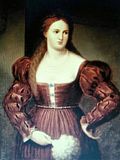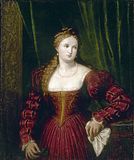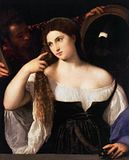ANOTHER BORDONE PORTRAIT
Paris Bordone (1495/1500-1570) painted many wonderful female portraits, and what I love about them is that he depicts a slightly different dressing style than the typical late Venetian and early Florentine fashion seen in so many recreations. His sitters wears what I'm tempted to call a "transitional style", when the dresses went from broad focus to a narrow focus. The bodices, which up until the 1520's had been fairly high-waisted and "loosely tied" in front, now started to gain length and get a more ornamented front lacing. Sleeves, which had grown into enormous propotions in Veneto in the 1510's and 1520's, much more than the balanced baragoni sleeves in Florence, started to gather the width at the shoulders, eventually ending in small shoulder rolls.
I recently found a gorgeous Bordone portrait at the Musei Mazzuccelli in Northern Italy:

I'm not sure what to think of it. I will be the first to admit that Bordone has a similar style in ALL his portraits and female figures, conforming them all to his "womany ideal". That's not unusual for a Renaissance painter. But the Mazzucchelli portrait looks like a perfect mirrored version of the Woman with a Hankerchief portrait, both in pose, in the lady's face and hairdo, and most particularly in the sleeves. There are slight variations in the placements and attributtes of the hands, and the execution of the bodices, but the similarity is uncanny.

The dress bodices is of particular interest to me. I have always wondered how such a magnificent style as the "Hankerchief" one is not seen elsewhere (neither in Veneto nor Tuscany, Lombardy or Rome - as far as I can tell). As much as I adore it, it always puzzled me, especially the combination of pointed waist, embroidery on the bodice and a golden "modesty panel". I wondered if it's meant allegorical in some way, but there are no to clear attributtes to a saint or a virtue. The hankerchief is a fashionable upper class symbol, and the flower hasn't given me any clues as of yet. The closest I've come to see some sort of "message" is that the bodice embroidery much echoes the "frieze" partly covered by the green backdrape. But what is that supposed to tell me?
But if dating would show that the Mazzucchelli portrait is older, it might help a bit. That kind of dress style is not to uncommon, as seen here:
VEN. SCHOOL:
http://img.photobucket.com/albums/v31/operafantomet/renaissanceportraits/venezia1/unknown1515-20ven.jpg
MORETTO:
http://img.photobucket.com/albums/v31/operafantomet/renaissanceportraits/venezia1/brescia1535.jpg (assuming this was originally tied together)
BORDONE:
http://img.photobucket.com/albums/v31/operafantomet/renaissanceportraits/venezia1/bordone1530s1.jpg
The blue bows towards the crimson dress is also a feature repeated in a later Bordone portrait:
http://img.photobucket.com/albums/v31/operafantomet/renaissanceportraits/venezia2/bordone1530s.jpg
At first I played with the thought of the Mazzucchelli portrait being a fraud, but it sounds unlikely. I'm actually more inclined to think that the embroidered Hankerchief portrait is a later painting by Bordone, either meant as an updated replica of the Mazzucchelli one, or as general repeat of a scheme he liked. But is it allegorical or fiction? What speaks against the Hankerchief one being a pure fantasy dress, is that the shape is quite plausible, and the trims, pipings etc. are very detailed, as they were based on a real garb. Both Bordone portraits posted above have a similar neck opening, and a similar golden trim at the bodice. It's the pointed waist and the large gold embroidery that ticks me off in the Hankerchief one (plus the golden modesty panel thing).
Either how, the both own a lot to the Woman with a Mirror painting by Tiziano Vecellio, when it comes to both pose, looks and the flowing hair:

I've updated the Bordone site a tad: http://www.geocities.com/pisslei/bordone.html